天津统计年鉴2017社会经济发展指标:规模以上服务业企业主要指标(2016年)
- 格式:xlsx
- 大小:14.73 KB
- 文档页数:2
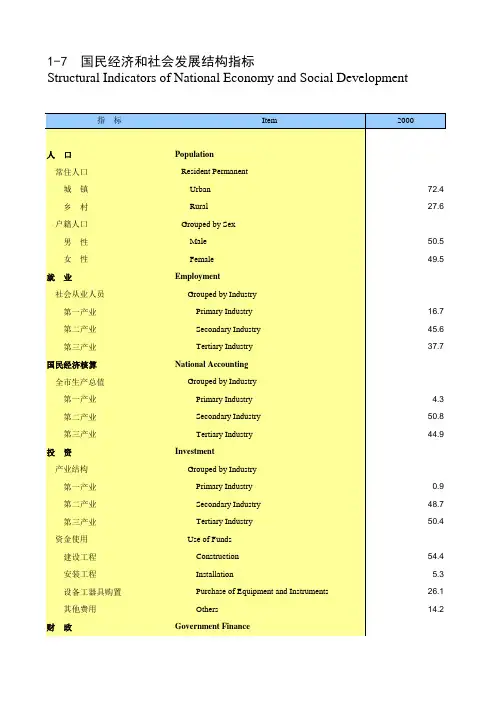
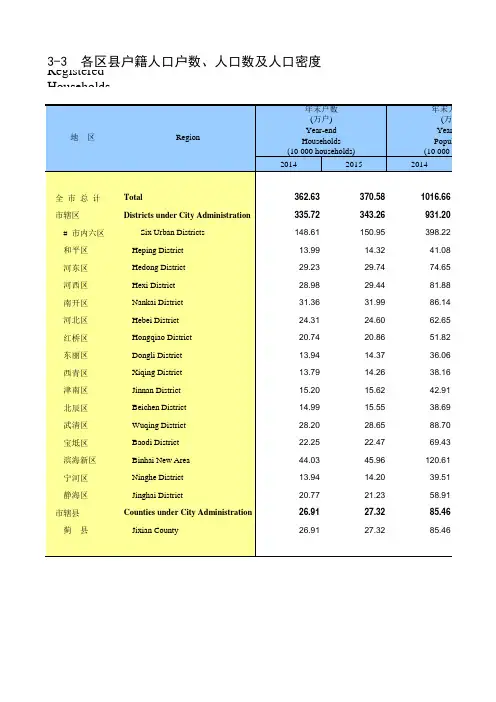
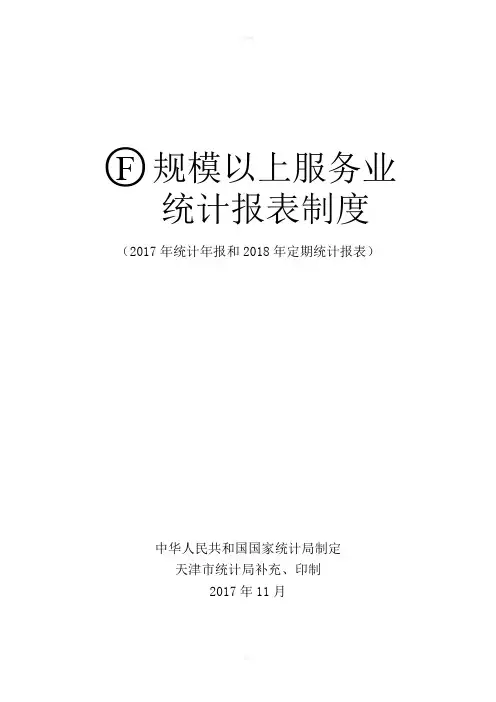
○F规模以上服务业统计报表制度(2017年统计年报和2018年定期统计报表)中华人民共和国国家统计局制定天津市统计局补充、印制2017年11月本报表制度根据《中华人民共和国统计法》的有关规定制定《中华人民共和国统计法》第七条规定:国家机关、企业事业单位和其他组织及个体工商户和个人等统计调查对象,必须依照本法和国家有关规定,真实、准确、完整、及时地提供统计调查所需的资料,不得提供不真实或者不完整的统计资料,不得迟报、拒报统计资料。
《中华人民共和国统计法》第九条规定:统计机构和统计人员对在统计工作中知悉的国家秘密、商业秘密和个人信息,应当予以保密。
本制度由天津市统计局负责解释。
目录一、总说明 (5)二、报表目录 (6)三、调查表式 (9)基层年报表式1.调查单位基本情况(101-1表) (9)2.从业人员及工资总额(102-1表) (12)3.财务状况(F103表) (13)4.非工业重点耗能单位能源消费情况(TF105表) (15)5.主要业务活动收入(108表) (16)6.信息化和电子商务应用情况(109表) (17)7.电子商务交易平台非四上法人单位基本情况(U104表) (18)8.四众平台基本情况(U105表) (19)基层定报表式1.调查单位基本情况(201-1表) (20)2.从业人员及工资总额(202-1表) (22)3.从业人员及工资总额(T202-1表) (23)4.财务状况(F203表) (24)5.非工业重点耗能单位能源消费情况(205-5表) (26)6.非工业重点耗能单位能源消费情况(TF205-5表) (27)7.能源生产、销售与库存(205-6表) (22)8.重点能源商品经销情况(205-7表) (23)9.生产经营景气状况(F210表) (24)10.电子商务交易平台情况(U201表) (22)11.重点互联网出行平台基本情况(U202表) (23)12.重点互联网医疗平台基本情况(U203表) (22)13.重点互联网教育平台基本情况(U204表) (23)14.合约类电子交易平台情况(U205表) (22)四、指标解释 (37)(一)调查单位基本情况 (37)(二)从业人员及工资总额 (48)(三)财务状况 (52)(四)信息化和电子商务应用情况 (57)(五)四众平台 (59)(六)非工业重点耗能单位能源消费情况 (61)(七)能源生产、销售与库存 (62)(八)重点能源商品经销情况 (65)(九)重点互联网平台 (67)五、国民经济行业分类和代码表 (68)六、国民经济行业分类新旧结构对照表 (92)一、总说明(一)为建立统一、规范的服务业统计,全面反映服务业发展状况,为各级政府进行宏观管理和决策提供依据,为国民经济核算提供基础数据,依照《中华人民共和国统计法》,制定本制度。
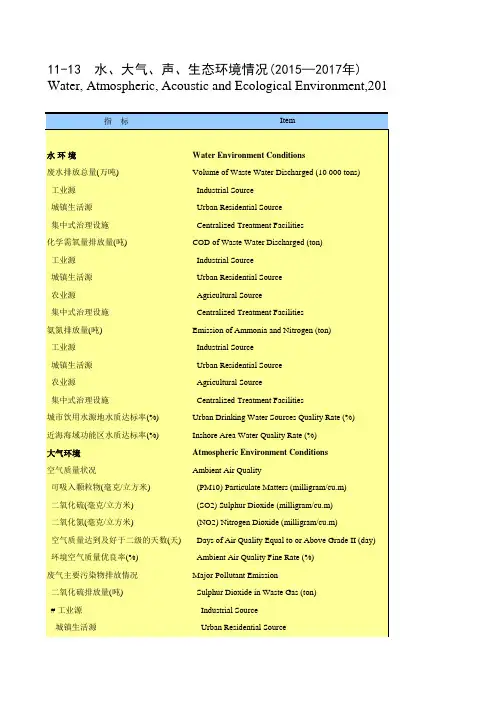
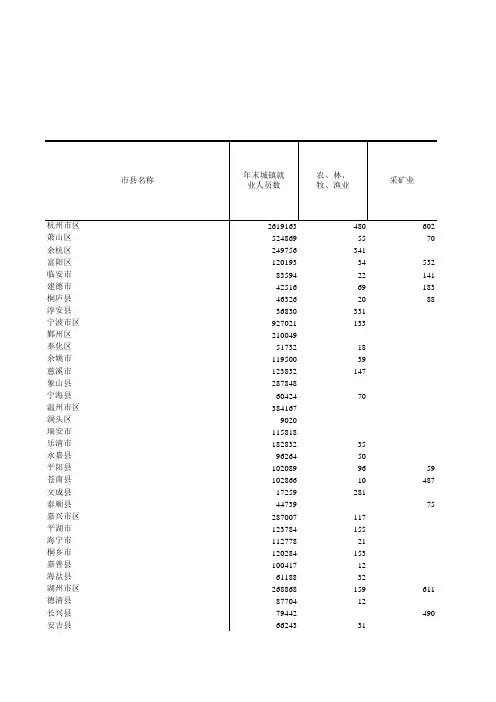
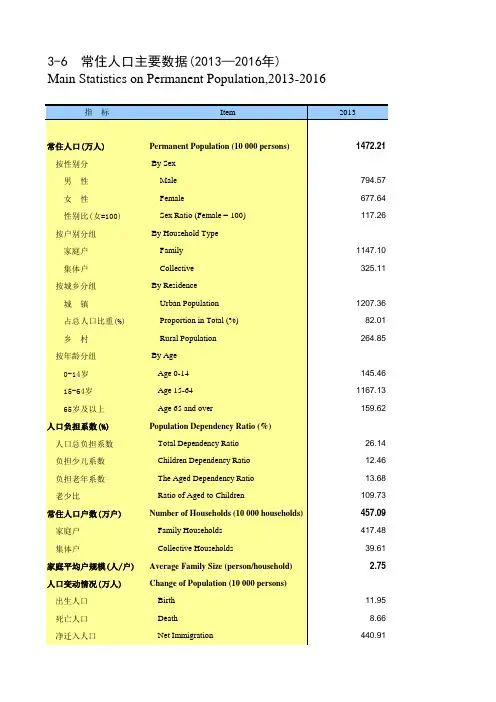
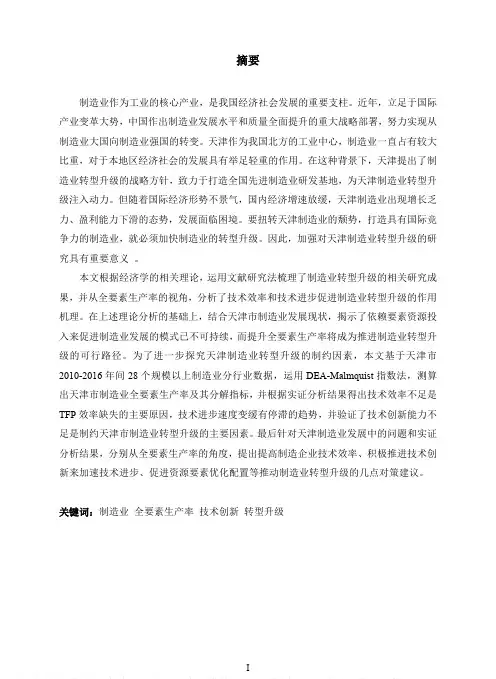
摘要制造业作为工业的核心产业,是我国经济社会发展的重要支柱。
近年,立足于国际产业变革大势,中国作出制造业发展水平和质量全面提升的重大战略部署,努力实现从制造业大国向制造业强国的转变。
天津作为我国北方的工业中心,制造业一直占有较大比重,对于本地区经济社会的发展具有举足轻重的作用。
在这种背景下,天津提出了制造业转型升级的战略方针,致力于打造全国先进制造业研发基地,为天津制造业转型升级注入动力。
但随着国际经济形势不景气,国内经济增速放缓,天津制造业出现增长乏力、盈利能力下滑的态势,发展面临困境。
要扭转天津制造业的颓势,打造具有国际竞争力的制造业,就必须加快制造业的转型升级。
因此,加强对天津制造业转型升级的研究具有重要意义。
本文根据经济学的相关理论,运用文献研究法梳理了制造业转型升级的相关研究成果,并从全要素生产率的视角,分析了技术效率和技术进步促进制造业转型升级的作用机理。
在上述理论分析的基础上,结合天津市制造业发展现状,揭示了依赖要素资源投入来促进制造业发展的模式已不可持续,而提升全要素生产率将成为推进制造业转型升级的可行路径。
为了进一步探究天津制造业转型升级的制约因素,本文基于天津市2010-2016年间28个规模以上制造业分行业数据,运用DEA-Malmquist指数法,测算出天津市制造业全要素生产率及其分解指标,并根据实证分析结果得出技术效率不足是TFP效率缺失的主要原因,技术进步速度变缓有停滞的趋势,并验证了技术创新能力不足是制约天津市制造业转型升级的主要因素。
最后针对天津制造业发展中的问题和实证分析结果,分别从全要素生产率的角度,提出提高制造企业技术效率、积极推进技术创新来加速技术进步、促进资源要素优化配置等推动制造业转型升级的几点对策建议。
关键词:制造业全要素生产率技术创新转型升级IStudy on transformation and upgrading of Tianjin’s manufacturingindustry:Based on the view of TFPAbstractAs the core industry,manufacturing is an important pillar of China's economic and social development.In recent years,the Chinese government,based on the general trend of international industrial transformation,has made major strategic arrangements to comprehensively improve the quality and level of development of China's manufacturing industry,striving to realize the transformation from a manufacturer of quantity to one of quality.As an industrial center in northern China,Tianjin's manufacturing industry has always occupied a large proportion and played a decisive role in the economic and social development of the region.In this context,Tianjin has put forward the strategic policy of transformation and upgrading of manufacturing industry,committed to building a national advanced manufacturing research and development base,and injected power into the transformation and upgrading of Tianjin manufacturing industry.However,as the international economic situation is sluggish and the domestic economic growth is slowing down,Tianjin's manufacturing industry is experiencing sluggish growth and declining profitability,and its development is facing difficulties.To reverse the decline of Tianjin's manufacturing industry and build a manufacturing industry with international competitiveness, we must speed up the transformation and upgrading of the manufacturing industry.Therefore, it is of great significance to strengthen the research on the transformation and upgrading of Tianjin's manufacturing industry.Based on the relevant theories of economics,this paper uses the method of literature research to sort out the relevant research results of manufacturing industry transformation and upgrading,and from the perspective of total factor productivity,analyzes the mechanism of technological efficiency and technological progress to promote the transformation and upgrading of manufacturing industry.On the basis of the above theoretical analysis,combined with the current development situation of Tianjin's manufacturing industry,it is revealed that the mode of relying on the input of factor resources to promote the development of manufacturing industry is no longer sustainable,and the promotion of total factor productivity will become a feasible path to promote the transformation and upgrading of manufacturing industry.In order to further explore the restrictive factors of Tianjin's manufacturing industrytransformation and upgrading,this paper uses DEA-Malmquist index method to estimate total factor productivity and its decomposition index of Tianjin's manufacturing industry based on the data of28above-scale manufacturing industries in Tianjin from2010to2016.According to the results of empirical analysis,it is concluded that insufficient technological efficiency is the main reason for the lack of TFP,the speed of technological progress is slowing down and has a stagnant trend,and it is verified that insufficient technological innovation capability is the main factor restricting Tianjin's manufacturing industry transformation and upgrading. Finally,according to existing problems in the development of Tianjin's manufacturing industry and the results of empirical analysis,this paper puts forward several countermeasures and suggestions to promote the transformation and upgrading of manufacturing industry,in the view of the perspective of total factor productivity.Such as improving the technical efficiency of manufacturing enterprises,actively promoting technological innovation to accelerate technological progress,and promoting the optimal allocation of resources.Keywords:Manufacturing industry Transformation and upgrading Technological innovation Total factor productivity目录第一章绪论 (1)一、选题背景与意义 (1)(一)选题背景 (1)(二)选题意义 (2)二、国内外研究综述 (3)(一)国外研究综述 (3)(二)国内研究综述 (4)(二)国内外文献述评 (5)三、研究思路、框架及方法 (6)(一)研究思路 (6)(二)研究框架 (6)(三)研究方法 (7)四、论文创新点及不足之处 (7)(一)论文创新点 (7)(二)论文的不足之处 (8)第二章相关概念界定及理论基础 (8)一、相关概念界定 (9)(一)制造业 (9)(二)制造业转型升级 (9)(三)全要素生产率 (10)二、制造业转型升级的相关理论 (11)(一)微笑曲线理论 (11)(二)雁形模式理论 (11)(三)主导产业理论 (12)(四)钱纳里工业化阶段理论 (12)三、全要素生产率影响制造业转型升级的内在机理 (13)(一)技术进步作用于制造业转型升级的内在机理 (13)(二)技术效率作用于制造业转型升级的内在机理 (14)第三章天津制造业发展现状及存在的问题 (16)一、天津制造业发展现状 (16)(一)天津制造业发展规模 (16)(二)天津制造业发展速度 (18)(三)支撑制造业发展的要素质量及配置状况 (20)二、天津制造业发展中存在的问题 (24)(一)制造业内部结构失衡 (24)(二)投资驱动作用减弱 (26)(三)科研创新能力不足 (28)第四章基于全要素生产率的天津制造业转型升级制约因素 (30)一、全要素生产率测算方法 (30)二、指标选取 (30)三、全要素生产率及其分解结果 (33)四、天津制造业转型升级的制约因素 (35)(一)整体分析 (35)(二)分行业分析 (36)第五章天津制造业转型升级的路径选择 (41)一、提高制造企业技术效率 (41)(一)完善企业管理制度,提高技术效率 (41)(二)提高科技人员技术水平 (41)(三)利用产业价值链,实现技术效率最大化 (42)二、积极推进技术创新,加速技术进步 (43)(一)提高自主创新能力 (43)(二)加强开放式创新,注重引进吸收国外先进技术 (43)三、促进资源要素优化配置 (44)(一)发挥市场竞争机制作用 (44)(二)政府引导要素流向,实现资源配置优化 (45)参考文献 (46)第一章绪论一、选题背景与意义(一)选题背景制造业是我国实体经济的主体,国民经济发展的支柱,对我国经济社会发展有着重要的影响作用。
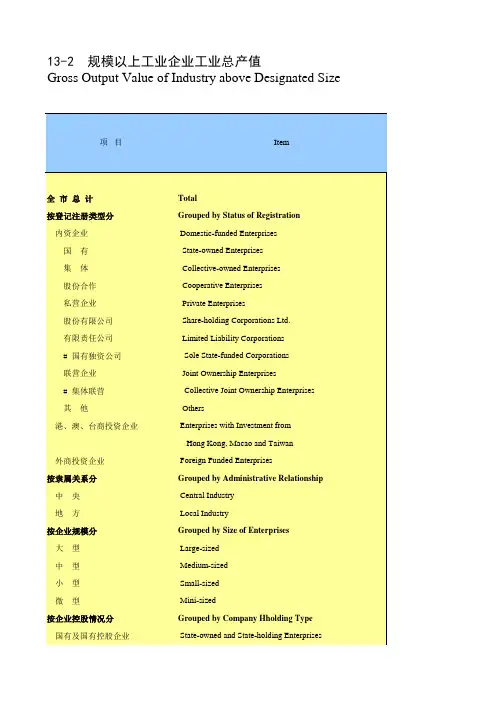
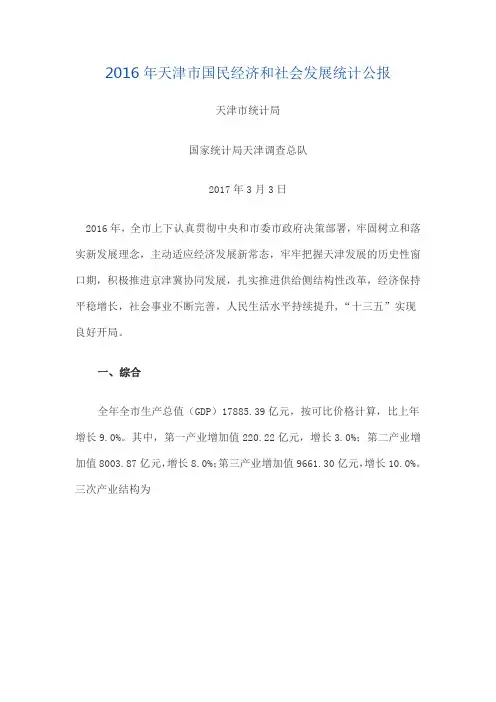
2016年天津市国民经济和社会发展统计公报天津市统计局国家统计局天津调查总队2017年3月3日2016年,全市上下认真贯彻中央和市委市政府决策部署,牢固树立和落实新发展理念,主动适应经济发展新常态,牢牢把握天津发展的历史性窗口期,积极推进京津冀协同发展,扎实推进供给侧结构性改革,经济保持平稳增长,社会事业不断完善,人民生活水平持续提升,“十三五”实现良好开局。
一、综合全年全市生产总值(GDP)17885.39亿元,按可比价格计算,比上年增长9.0%。
其中,第一产业增加值220.22亿元,增长3.0%;第二产业增加值8003.87亿元,增长8.0%;第三产业增加值9661.30亿元,增长10.0%。
三次产业结构为1.2:44.8:54.0。
图1 2012-2016年全市生产总值和服务业比重财政收支增势平稳。
全年一般公共预算收入2723.46亿元,增长10.0%。
其中,税收收入1624.18亿元,增长12.1%,占一般公共预算收入的59.6%。
从主体税种看,增值税455.80亿元,增长36.4%;企业所得税278.42亿元,增长7.1%;个人所得税96.78亿元,增长18.4%。
民生支出不断扩大。
全年一般公共预算支出3700.68亿元,增长6.3%。
其中,社会保障和就业支出378.27亿元,增长20.2%;医疗卫生支出206.07亿元,增长10.8%;住房保障支出66.75亿元,增长31.9%。
投资保持较快增长。
全年全社会固定资产投资14629.22亿元,增长12.0%。
在固定资产投资(不含农户)中,第一产业投资289.15亿元,增长19.5%;第二产业投资3940.48亿元,增长6.5%;第三产业投资10376.56亿元,增长14.0%,比重达到71.0%,比上年提高1.3个百分点。
实体投资主体地位进一步显现,完成投资9590.06亿元,增长17.2%,占固定资产投资的65.7%;基础设施投资2716.12亿元,占固定资产投资的18.6%。